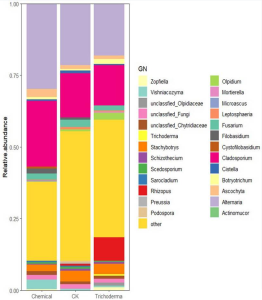A group from School of Bioengineering, Qilu University of Technology (Shandong Academy of Sciences), Jinan, China, etc. has reported about effects of inoculation of Trichoderma atroviride HB20111 onto wheat rhizosphere microbiome.
https://www.ncbi.nlm.nih.gov/pmc/articles/PMC9188553/
Fusarium crown rot and wheat sharp eyespot are major soil-borne diseases of wheat.
Biological agents Streptomyces, Bacillus subtilis, Pseudomonas, Actinomyces, Trichoderma, etc. can reduce the colonization of pathogenic fungi, produce antibiotics and organic compounds in the soil, and promote plant growth. Seed dressing is a cost-effective method that has the potential for large-scale application in the prevention and control of crop diseases. As a biocontrol agent, Trichoderma seed dressing has been increasingly used to control plant fungal diseases. Common pathogens controlled by Trichoderma include Bipolaris sorokiniana, F. pseudograminearum, F. oxysporum, R. solani, R. cerealis and many other plant pathogens.
The copy number measured by qPCR of total fungi in T. atroviride HB20111 treatment was lower 47.2% than that of the control. Ascomycota and Olpidiomycota were changed significantly in the rhizosphere fungal community following Trichoderma seed dressing, compared with the control, among which, the content of Ascomycetes decreased by 54.2%, and the Olpidiomycota increased by 54.8%. Trichoderma treatment reduced the relative abundance of Fusarium spp. The relative abundance of Alternaria spp. in the Trichoderma treatment decreased by 3.26% compared with the control. These decreases were accompanied by notable increases in the relative abundance of Olpidium and Botryotrichum in the rhizosphere soil.
As a result of the Trichoderma treatment, for Fusarium crown rot, Trichoderma treatment reduced the disease index by 64.3%, and the yield of wheat treated with Tricoderma seed dressing increased by 7.7% compared with the control.

